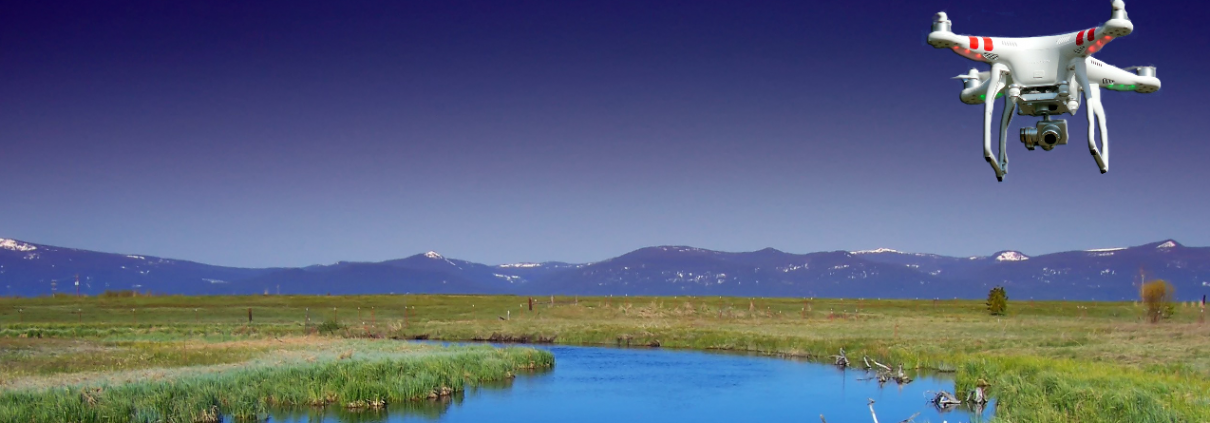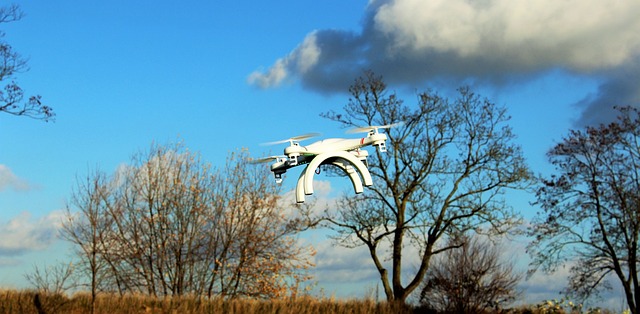This article originally appeared in the REALTORS® Land Institute’s Summer 2017 Terra Firma magazine.
Drone. It’s a word that elicits different feelings for different people. Some people love them, others hate them. Some people see their incredible potential while others wish they didn’t exist. Headlines range from “Drones are saving puppies” to “Drones are ruining my life”. The issue can be polarizing.
As a land professional, a drone can be a powerful and effective tool for your business. The current and potential uses are varied and creative. The opportunity is huge and it’s important to be well-informed regarding the proper use of drones.
As with any “hot-topic” issue, there is a lot of bad information that gets into public view; and having bad information can result in poor decisions, lost business, and even legal penalties. I am writing this article because I want you to be an informed, intelligent, and passionate ambassador for drones and their incredible potential in real estate. As such, I want to provide specific, reliable, and accurate information on how to legally operate a drone in your business. I also want to provide you with resources for further research and up-to-date information.
To achieve that goal, I am going to focus on the nuts and bolts of completely legal commercial drone flying. I’m not going to tell you which drone to buy, how to get the best shots, or what time of day offers that epic cinematic effect. I am going to tell you exactly how to operate within the Federal Aviation Administration’s (FAA) rules and guidelines for commercial drone use.
Below are three basic overarching maxims that are central to all legal, commercial drone operations. These are presented as fact, insofar as they are published in FAA guidance, law, or other official means. So, regardless of what you’ve heard on the news, read on the Internet, or been told by your brother-in-law, here is the scoop:
THE ONLY LEGAL WAY TO OPERATE A DRONE COMMERCIALLY IS THROUGH A SECTION 333 EXEMPTION ISSUED BY THE FAA
The FAA is currently using an EXEMPTION process to allow legal commercial drone use. This process is filling the gap until full-fledged regulations can be finalized and published. Until recent years, “model aircraft” have been used almost exclusively for recreational purposes. In the past decade, inexpensive drones with the ability to capture high-quality video and photographs have flooded the market. This has given the FAA a lot of heartache, because they did not yet have rules in place to regulate “commercial model aircraft”. The exemption process is the only avenue currently available to operate legally for hire.
In order to receive an exemption, you must apply at www.regulations.gov. Follow these instructions for the application process.
This is how it’s done: read through a few petitions, copy someone else’s petition, personalize it to yourself or your company, include the necessary documentation, and submit. It’s not college English class so plagiarism is not only allowed, it is actually encouraged. You want to make it as easy as possible for the FAA to say yes by submitting an application very similar to one that is already approved. When I applied for my exemption, the FAA’s stated processing time was ninety to one-hundred and twenty days. I received my approval in eighty-seven days. It was the first time in my life a government entity had done something faster than advertised. Some people have hired lawyers, others have hired so-called “Section 333 Exemption Companies” to write and submit the application for them. That is unnecessary. The process is simple and the instructions are clear.
THE OPERATOR OF THE DRONE MUST BE AN FAA LICENSED PILOT
After reading number two, you may be thinking, “I’m not a pilot. I’m never going to become a pilot. Why should I apply for this exemption?” The person applying for the exemption DOES NOT HAVE TO BE A PILOT. The person OPERATING the drone DOES have to be a pilot. Of the over five-thousand exemptions granted to date, many of them have been companies or individuals who are not licensed pilots. You can have a pilot working for your company, or contract with one who can legally fly the drone. This will allow more flexible and on-demand scheduling to keep your costs lower. The exemption will require a certain level of drone training and logged flying hours. But any level of FAA license will do – from Airline Transport Pilot all the way down to Sport Pilot.
UPDATE
THE DRONE MUST BE REGISTERED, COMMERCIALLY, AS AN AIRCRAFT
Because the FAA, with the input of the courts, has determined that a drone is an aircraft (Google: Raphael Pirker Drone), it must be registered. For commercial drones, this once meant filling out a paper form (carbon paper included) and sending it, along with other documents, to the FAA. Luckily for all of us living in 2016, in April of this year that process was moved online. In order to register your drone, you must visit https://registermyuas.faa.gov, pay a five-dollar registration fee, label your drone with the registration number provided, and you’re good to go. This is the FAA’s way of finding you when you crash your drone on the White House lawn. Flyers beware!
(As a side note, recreational drones also require registration if they weigh over 0.55 pounds).
When you receive your exemption, it will be accompanied by a long list of dos and don’ts that you must abide by. These requirements range from pre-flighting your drone to maximum altitudes you can fly. Here are some of the basics:
- No flights above four-hundred feet Above Ground Level (AGL)
- Drone must remain within Line-Of-Sight (LOS)
- If operator is using First Person View (FPV), looking at the video feed instead of the drone, he must have a Visual Observer (VO) to maintain LOS
- No flights within five miles of an airport with a control tower or within three miles of an airport without a control tower, UNLESS a Certificate Of Authorization (COA) has been issued and the Operator has coordinated with the airport control tower
- Must stay five-hundred feet away from non-participating persons at all times
Below is a list of resources where you can stay updated on everything contained here. This an ever-evolving issue. Be sure to check back often for updates and changes.
- A one-stop-shop for general info on rules, safety, registration, etc.
Now, I’m certainly not naive enough to believe that none of you have ever flown a drone commercially without the required exemption, licensing, and registration. It’s true that thousands of people have taken aerial video and photography this way; and the vast majority of them never face any issues from the FAA. However, I would submit that as land professionals and REALTORS®, we should all strive to operate within the rules. We need to be doing things the right way, every time, all the time.
To their credit, the FAA is taking steps to make things easier for everyone who wants to operate a drone. I have seen at least two examples of LESSENING of restrictions for Section 333 exemption holders in the past few months. These include an increase in the allowable altitude from two- to four-hundred feet and the publishing of a blanket list of drones you can fly once you receive your exemption (previously each petitioner had to list all drones intended for use and provide all documentation for each drone).
So, what does the future hold? Good news! The proposed rules going forward provide for approving drone operators WITHOUT a pilot’s license and WITHOUT a Section 333 Exemption. Applicants for a Drone Operators License (for commercial operations) will be required to complete online education, pass a Transportation Security Administration (TSA) background screening, and pass an FAA knowledge test. These proposed rules are still being vetted, discussed, and debated to determine the final rules. However, the rules are a great framework to lessen the burden of legal operation while still maintaining appropriate training and safety measures. Plans are also moving forward to allow flight over non-participants – as long as the specific drone being flown meets certain industry standards. The timeline on the final rules is uncertain. Yet, industry stakeholders and individuals alike are putting a lot of pressure on the FAA and Congress to get it done.
For now, we have to operate within some tight restrictions, but drone technology, uses, and regulation are all evolving very quickly. If you haven’t already, get ready to join the world of drones – an exciting industry with virtually unlimited potential!
 About the author: Caleb McDow is a land specialist for Crosby and Associates in Winter Haven, FL, with a Master of Science in Real Estate (MSRE) and is a FAA Certified Drone Pilot. McDow joined the institute in 2014 as a Military Transition Program (MTP) member. He serves on the Institute’s Future Leaders Committee and regularly blogs on real estate issues.
About the author: Caleb McDow is a land specialist for Crosby and Associates in Winter Haven, FL, with a Master of Science in Real Estate (MSRE) and is a FAA Certified Drone Pilot. McDow joined the institute in 2014 as a Military Transition Program (MTP) member. He serves on the Institute’s Future Leaders Committee and regularly blogs on real estate issues.
 About the author: Caleb McDow, ALC, is a land specialist and vice president for Crosby & Associates in Winter Haven, FL. He holds a Master of Science in Real Estate (MSRE), the CCIM Designation, and is a licensed private pilot and drone operator. McDow joined RLI in 2014 as a Military Transition Program (MTP) member. He is an active member of RLI, serving on the 2017-2018 RLI Board of Directors and as Chair of the 2018 Future Leaders Committee. He also regularly shares his expertise on real estate issues for various industry blogs.
About the author: Caleb McDow, ALC, is a land specialist and vice president for Crosby & Associates in Winter Haven, FL. He holds a Master of Science in Real Estate (MSRE), the CCIM Designation, and is a licensed private pilot and drone operator. McDow joined RLI in 2014 as a Military Transition Program (MTP) member. He is an active member of RLI, serving on the 2017-2018 RLI Board of Directors and as Chair of the 2018 Future Leaders Committee. He also regularly shares his expertise on real estate issues for various industry blogs.










 About the author:
About the author: 
